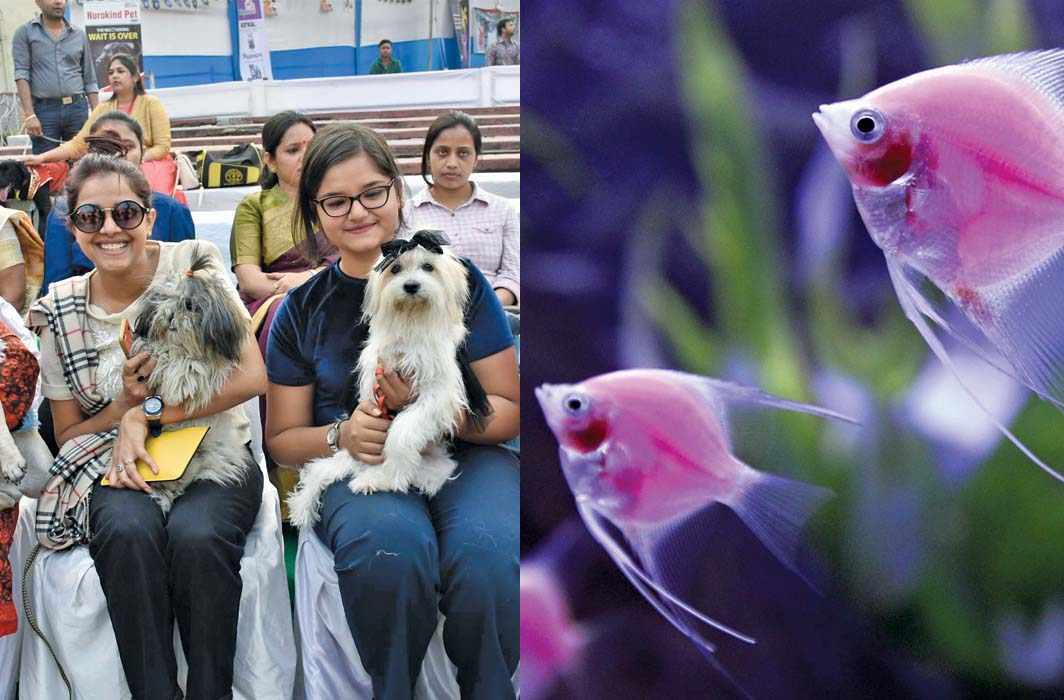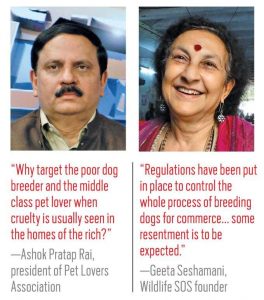Above:The new rules for breeding are detailed, exigent and may not be cost-effective as a business or a hobby. Photo: UNI
Many pet lovers and breeders find the new Prevention of Cruelty to Animals rules pertaining to the care and upkeep of domestic animals absurd, excessive and discouraging
~By Sucheta Dasgupta
Are you a pet lover? A breeder of pedigree dogs? A rearer of livestock? You might very well find yourself on the wrong side of the new Prevention of Cruelty to Animals (Dog Breeding and Marketing) Rules, Prevention of Cruelty to Animals (Regulation of Livestock Markets) Rules and Prevention of Cruelty to Animals (Aquarium and Fish Tank Animals) Rules, promulgated by the Government of India.
On May 23, 2017, the ministry of environment and forest notified these three sets of rules pertaining to the care and upkeep of domestic animals in India. The Prevention of Cruelty to Animals (Regulation of Livestock Markets) Rules have already sparked a furore over their stipulation proscribing sale of cattle for slaughter in markets.
Admitted that the punishment for most violations is a paltry fine of Rs 150-200, the “lawbreaker” also stands to lose his animal(s) and a criminal record against him means, according to the new Rules, cancellation of registration and loss of licence to deal in them. So what makes the Rules—those related to fish and dogs—such a minefield to tread on? Indeed, the devil is in the detail.
But it is also in the methodology and the implementation.
COSTLY AND IMPRACTICAL
The Rules hardly make life easier for the dog breeder and the fish tank owner. To begin with, there is the issue of registration. Dog breeders and fish tank owners must now register themselves with the state animal welfare board, filing one application per establishment. Each application entails a non-refundable fee of Rs 5,000.
The application will be followed by an inspection team comprising people authorised in writing by the board. Ashok Pratap Rai, president of Pet Lovers Association, and some others fear that these persons may not be competent and might even have vested interests. Fish tank owners must submit a master plan with a blueprint and a collection plan to be approved by the state board. In most cases, the fish trader is uneducated and not in a position to draft these plans.
Upon completion of inspection, the team must submit a report to the board signed by all members, instead of, as one would expect, only the team head. There are concerns that this might lead to unnecessary delay, inimical to the business of the breeder or tank owner.
Additionally, fish tank owners must procure no objection certificates from the local fisheries department and, in coastal zones, from the National Coastal Management Authority. Already, the pet shop rules prohibit the housing of dogs, fish and birds in the same establishment, making all this hardly cost-effective.

The registration will be valid for two years following which it must be renewed after payment of the same fee. The application for renewal must be made 30 days prior to the expiry of the previous registration. This period is 60 days in the case of fish owners.
TOO MANY STIPULATIONS
The next hurdle for breeders and fish owners is the list of specifications concerning how and where animals should be housed. The rules stipulate no more than 12 dogs in a single enclosure, strict temperature control of the environment which requires installation of an air-conditioner (even though many species of dogs are hardy enough to survive Indian summers) and enclosure sizes too specific to comply with.
For example, fish bowls are no longer allowed and so are fish tanks with a capacity of less than 60 litres of water. Sounds excessive? Well, the Rules also say that water oxygenation must always remain above 80 percent, which any expert would say is unnecessary, says Rai, himself, an aquarium owner. The rules call for testing of salinity and pH levels weekly. “We can only use the water that is provided by the corporation, can’t we?” quips Rai.
The fish tanks may not be placed at locations where there is always light or in a place where there will be “constant vibrations from traffic or movement of large numbers of people”. Such as a marketplace? Where else will aquarium sellers set shop?
The Rules ask aquarium owners to maintain a record of fish deaths. This demand is not scientifically ratified as in the aquarium ecosystem, dead fish are often eaten by other fish and might slip the notice of the fish owner, especially part of large shoals of very small species.
Owners are also asked to employ a full-time fish veterinarian or an expert, rather than ensure access to one when required; unnecessary and not cost-effective for a business or a hobbyist.
A statutory body under the Ministry of Environment, Forest and Climate Change has framed the rules but none of the animals being protected are wild animals.
But this is not all. Dog breeders must ensure that the vet identify all dogs and pups over three months through micro-chipping, dog tags are sequentially numbered and referenced and the micro-chip be sequentially numbered, too—a cumbersome process to track the source of the dog. Breeders are naturally chary of revealing purchase information of dogs to customers to keep intact their profit margin.
IRRATIONAL AND TOO RADICAL
The Rules call for monthly checkup of dogs, something not mandated anywhere in the world (and will burn a hole in the owner’s pocket given that government pet hospitals are few or non-existent—the capital has just two—and private clinic prices are sky-high), eight-hourly meals (not even police dogs on an exemplary diet are fed so frequently) and a breeding age limit of eight years for female dogs after which the dog must be kept separated from its companions which is an act of cruelty in itself and also unfeasible for the breeder.
Puppies older than six months cannot be sold without being sterilised, according to the Rules. Says Ajay Pratap Singh, dog lover: “It is in dog shows that we come to learn the potential of an animal. The minimum age of participation in these shows is six months. But if this rule is followed, the animals, even if they perform superlatively, are practically useless. As dog import is banned since last year, it makes breeding good specimens particularly challenging. The government is not respecting the practices of Dog Breeders Association and Kennel Club of UK which is over 135 years old. If a dog is well, there is no reason to take action against its owner.”
Rai feels that the Rules are unnecessary, “too radical” and they ignore “the human factor”. “Why target the poor dog breeder and the middle class pet lover when cruelty is usually seen in the homes of the rich?” he asks.
Rai argues that the government must instead intervene in areas where help is required. Entry of dogs is banned in parks and the animals have no place to play and exercise. Strays are not sterilised and the NGOs, which take a fee of Rs 450 to perform the surgery per dog, does not offer post-operative care. “Is that not cruel?” he enquires. Citing reports of maulings and killings by packs of strays in cities such as Bengaluru, he asks why the government is silent on this issue. As a solution, he says that the government must directly provide the sterilisation service to control the population of stray dogs.
NOT THE RIGHT BODY?
“Who made the rules? Are they the competent authority? And how will they ensure these are being followed? Do they have the manpower to monitor all of India’s 707 districts? In the hands of vested interests, these rules will become a tool of exploitation. Coming on the heels of demonetisation, they will hit the pet market hard and throw tens of thousands of people out of their jobs,” says Rai. The Association he heads has filed two writ petitions in the Supreme Court —one to prevent any NGO from taking direct action against pet shops and individual breeders and the other to overturn the Gujarat High Court’s judgment in a case related to the Wildlife Act 1972 which, incidentally, allows individuals to keep exotic pets—both in 2015.
 Both cases are sub judice. But the latter has led to the apex court serving notices on the ministry of environment and forest and the Gujarat government, which had seized an exotic bird owned by a resident of the state. PLA hopes to challenge the Dog Breeding and the Aquarium and Fish Tank Animals Rules in court at a later stage.
Both cases are sub judice. But the latter has led to the apex court serving notices on the ministry of environment and forest and the Gujarat government, which had seized an exotic bird owned by a resident of the state. PLA hopes to challenge the Dog Breeding and the Aquarium and Fish Tank Animals Rules in court at a later stage.
The question of who framed the Rules is a pertinent one. It is the Animal Welfare Board of India, a statutory body under the Ministry of Environment, Forest and Climate Change, which has framed the rules. Rai contends that the responsibility should have been that of the animal husbandry department and the fisheries department which come under the ministry of agriculture, the reason being that none of the animals being protected are wild animals.
ALTERNATIVE VIEW
Since the Rules are meant for dog breeders, they do not apply to animal shelters run either by NGOs or the government. Should there be a manual for them containing similar guidelines? But had it been issued, would the stakeholders find the rules harsh, excessive or even inimical, deterring them from doing their work?
Asked this question, Wildlife SOS founder Geeta Seshamani, who is also associated with the charitable organisation, Friendicoes, interestingly, disagreed. “The important thing is that regulations have at last been put in place to control the whole process of breeding dogs for commerce. This would curb the cheating of unsuspecting customers who are handed sick pups and also go a long way in regulating a highly unethical trade that exploited dogs cruelly.” She also felt that the Rules are clear and well-defined and that “compliance should not be a problem” even as “some resentment is to be expected owing to the emphasis on accountability”. “But the fact is that the Rules are essential and something we have awaited for a long time,” Seshamani opined.
This is a complementing viewpoint. Pet love, it certainly seems, is a battlefield.


